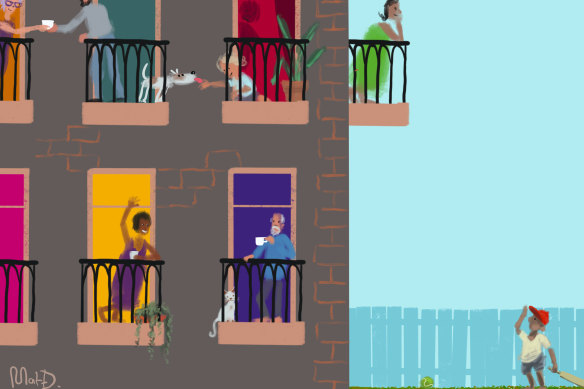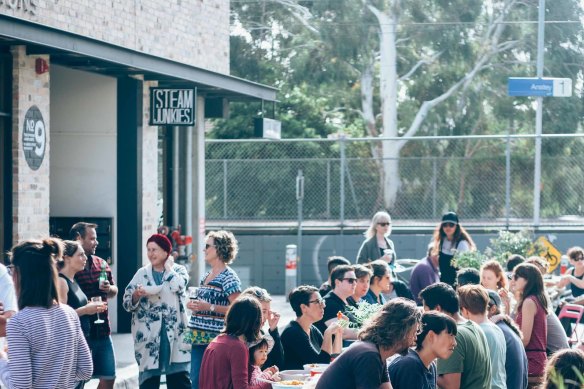Save articles for later
Add articles to your saved list and come back to them any time.
The great Australian dream of owning a house, has all but collapsed. Where we’ve landed has been building for some time (pun intended). I felt the sting of this when, without warning, I was hit with a 30 per cent increase in rent. No matter that the house had been my home for nearly 15 years and the suburb for more than 25. The area had become highly sought-after and it seemed that now, those of us who had lovingly poured out our hearts and lives within its boundaries were no longer needed. One couldn’t help but feel a general attitude that if you couldn’t afford to live there, well, you just couldn’t afford to live there. Head north.
I was raised on the promise of the Australian housing dream – a house with a backyard, as big as one might be able to achieve. I grew up on a suburban block in Box Hill North in the ’70s. On it, a small weatherboard house that my dad renovated in the ’80s, a front yard with a huge golden ash, and a backyard that had a gate cut into the fence so we could easily get to our neighbours, Beryl and Ralph.
Apartment life is rapidly becoming the norm for many people, with homes with a big backyard becoming unaffordable for some.Credit: Matt Davidson
On cold winter afternoons, we’d be shoved out of the house to spend the remaining daylight running between the front and backyard in the mud and the garden beds, attacking each other, fighting, ganging up – the usual. I expected one day, I would have my own house like this complete with a backyard, almost enough bedrooms for everyone, a kitchen big enough for a table for six of us to sit around, and a big garage out the back like the one where my dad did his “backyarders” – fixing the cars of the people in our neighbourhood.
When I did say goodbye to the family home, it was to live in share houses around inner-city Melbourne. These rundown houses rarely had heating and certainly didn’t have landlords willing to fix walls as they crumbled around us. But they were rambling houses with backyards and multiple bedrooms to fit us all in. Time passed and my life became more entrenched in Melbourne’s inner suburbs: jobs, friends, then kids and kinders, communities and schools and suddenly I had lived 25 years in an area where I couldn’t afford to rent a house any more, let alone buy.
When apartments had started to spring up in our precious inner-suburban neighbourhood, I derided the hapless development and unnecessary growth. I guess I was a NIMBY. The unsightly buildings contrasted with the old Italian neighbourhoods I lived in where grapevines ran the length of carports, there were olive trees on nature strips and veggie gardens on every spare bit of land. I joined the chorus of disappointed residents who were bemoaning the shifting landscape and made quick assessments that apartments were about excessive development geared to enhance profit margins of developers. I couldn’t have been more wrong.
The reality of this housing crisis is that it is felt most keenly by those who are young and those on lower incomes. Older Australians in the middle- and upper-income brackets might be wondering what all the fuss is about.
A Per Capita report into the housing crisis commissioned by V&F Housing Enterprise Foundation found that while there is “plenty of market-rate housing … the problem is a severe and compounding lack of quality social and affordable housing for those at the bottom of the income scale”.
Apartment residents catch up in Melbourne’s inner north.
There are solutions that have been apparent for decades, but they revolve around shifting long-held expectations on tax concessions, lack of social and affordable housing and other government policies that have encouraged speculation. Solutions will need to focus on shifting the policy dial on property as “investment and capital growth”, towards property as it was understood before the ’70s – as a human right.
Experts seem to agree that one of the necessary answers belongs to the ever-increasing need for quality, medium-density housing, located in established neighbourhoods with access to transport and amenities. Infrastructure Victoria, the state’s independent infrastructure adviser, has found that compact cities perform better than other models of housing development because they connect communities to jobs, services and infrastructure. The biggest push-back is from residents who don’t want their neighbourhoods to change. For a long time, local and state governments have listened, but the tide is changing. That said, the NIMBYs are right to be cautious about the types and quality of developments that take place in their neighbourhoods.
After realising my inability to pay the rising cost of rent was an issue that would not go away, I saved every cent I could by drastically cutting shopping bills, borrowed from kind strangers, and eventually bought an apartment in my neighbourhood. I unburdened myself of all the unnecessary stuff I had been carrying from house to house for years, and thought deeply about how a family of four large personalities would manage such a small space.
Not only was I wrong about the apartment being a compromise on a house – I can safely say I will never choose to live in a detached house with a backyard again. In this building, I have found a family, a vibrant community I couldn’t hope to establish in even the most willing of neighbourhood streets. When we were locked down and unable to see friends or family, just knowing that I was in a building with people I knew and trusted was an enormous comfort.
There has been an intentional development of a community in our building – we have consciously coupled. We share laundry facilities and communal spaces. I share parenting with my friend, Kat, upstairs and my sister moved into the floor above. What I have lost in backyards with kids running around has been replaced with a building where kids are born and run around and experience what it really means to live in reliance with your neighbours who are of all ages and life stages. If the lift breaks, there is an army of people ready to help get it fixed. We have a gardening committee, waste warriors, laundry committee and a subject heading in our Slack account called #whelmed – for all the oddities of life that we need to share with someone. (Why does the toilet button suggest a small flush when it is in fact a big flush? Anyone else?)
My neighbourhood is vertical.
Jacinta Parsons is a Melbourne writer and co-host of The Friday Review on ABC Radio Melbourne.
The Opinion newsletter is a weekly wrap of views that will challenge, champion and inform your own. Sign up here.
Most Viewed in National
From our partners
Source: Read Full Article


